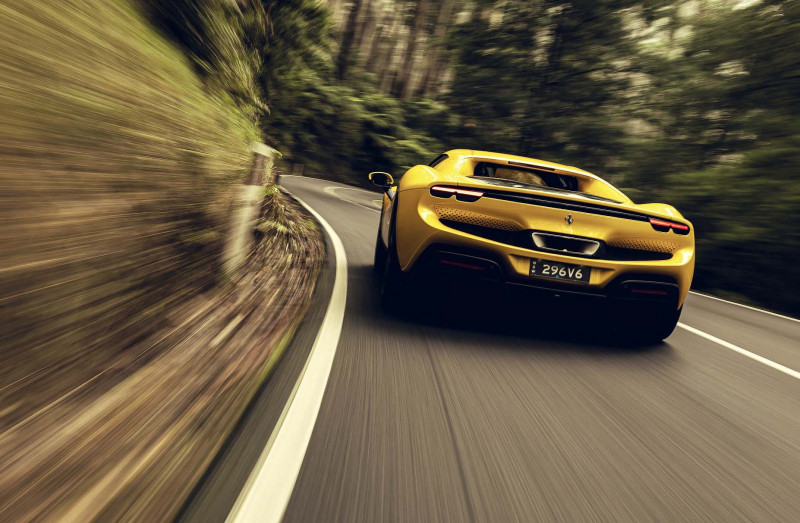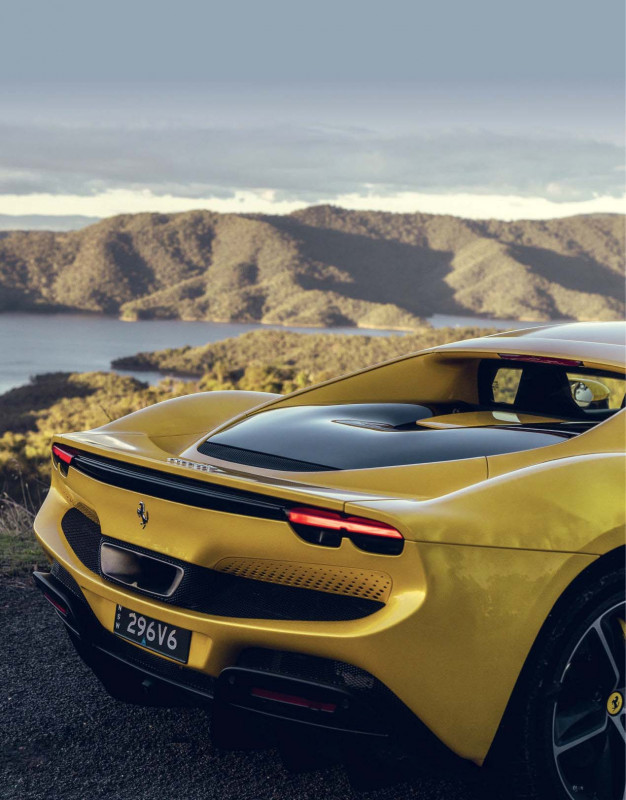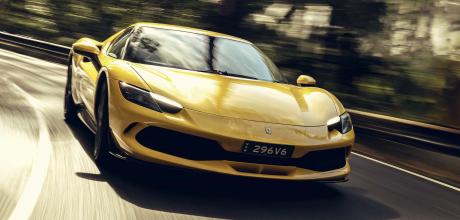Road test 2024 Ferrari 296 GTB F171
The 296 is ferociously fast and fiendishly clever but Enright asks if the supercar still has a place in today’s world. Ferrari’s incredible 296 GTB offers an opportunity to consider how far the supercar has come and whether the genre still retains its Lustre.
Words Andy Enright
Photos Ellen Dewar
FEATURE DRIVE / FERRARI 296 GTB SUPER OVER

A pickle inspired this story. More accurately, a slice of pickle. It arced through the air from the passenger window of a Hilux just as the filter light turned green, hitting the windscreen of the yellow Ferrari with a fat splat. I watched it start to slide down the glass before the coefficient of friction arrested it, waiting for me to figure out which of the steering wheel controls operated the wiper. For a moment I was captivated by that pickle. Not for what it was, or for the fact that whoever threw it would have to negotiate his burger without it, but more for what it represented. It was as much a slice of resentment as a slice of dill. The car I was driving had provoked such a visceral reaction that, in that moment, I couldn’t quite decide whether that was a good or bad thing. You certainly don’t buy a supercar to be ignored.

The Ferrari 296 GTB isn’t readily overlooked. At the moment it’s the supercar du jour. With 820bhp/610kW of electrically-boosted power at its elbow, its acceleration to 200km/h is to a McLaren F1 what a McLaren F1 is to a Porsche 718 Cayman GT4 RS: of a wholly different dimension. It’s worth reminding ourselves that this is the baby, an entry-level mid-engined Ferrari, powered in this instance by a dinky 3.0-litre V6. It wields that power judiciously. Mat the throttle hard and there’s none of that tarmactearing rambunctiousness of a McLaren 720S, at least not away from a standing start. It’s quick but not Plaid-style concussive.

Ferrari has been limiting torque in the lower gears since the introduction of the 3.9-litre F154 turbo V8 in the California T. Whereas that had been quite a subtle way of introducing the Cali’s 755Nm to the rear treads, it’s now far more pronounced, with a surprisingly civil launch process before, battery condition and drive modes allowing, the 296 looses off the full avalanche of Newton metres in third gear.
When I was a kid, the Ferrari Testarossa was for a while, my personal pin-up. I devoured any magazine road test on it, goggling at the outlandish performance figures, trying to process what 18.1 seconds to 200km/h might feel like. The 296 GTB? Try 7.1 seconds. It’ll accelerate to 200km/h and be back to a standstill before the old stager had lumbered up to 160. By the time the Testarossa was at 200km/h the 296 would be well north of 300.
But here’s the supercar’s current dilemma. While it was once an ultimate, a genre that represented the very extreme of what car manufacturers could envision, that’s no longer the case. The performance of a modern hypercar like a Rimac Nevera would demolish a 296 GTB and by a frankly astonishing margin. The Croatian EV will get to 200km/h in 4.4 seconds. It’ll accelerate to the imperial double-ton of 200mph in 10.86 seconds; fully 17 seconds quicker than a McLaren F1. Anyway, enough of the numbers. What matters is that the supercar is, by today’s standards, a creature of compromise.
How it became so perhaps merits a little consideration and I lay the blame for that squarely at the feet of the Porsche 959. Prior to the point that the 959 appeared at the 1985 Frankfurt show, there had been a certain predictable linearity in the development of the supercar. Plot a line through the 1954 Mercedes-Benz 300 SL Gullwing W198, the 1962 Ferrari 250 GTO, the 1966 Lamborghini Miura and the extended Countach lifespan and you arrive at that mid-’80s inflection point.
Porsche showed its hand with the 959, Enzo’s knee jerked and the F40 appeared. The Ferrari, despite the company’s promises of limited numbers, was very much a development of the supercar species. It was like everything that had come before, only more so. The Porsche was different. It was a performance car the like of which we’d never seen. With all-wheel drive that featured dynamic torque splitting, composite body and chassis, active aerodynamics and computerised active suspension, it diverged from the path of the supercar, yet at the time few appreciated that significance.
While the supercar line then ascended in steps from the F40 to Lamborghini’s Murcielago and Aventador, via McLaren 720S to arrive with this Ferrari 296 GTB, the nascent hypercars adopted the technological focus of the 959. Five years after the 959 was unveiled, the astonishing Bugatti EB110 followed, with its 60-valve V12 fed by four turbochargers and driving four wheels. The McLaren F1 was an analogue outlier before the Bugatti Veyron’s engineering brutality eclipsed it. Beyond that, electrification elevated performance onto an ever higher plane with the hybrid hypercar holy trinity of LaFerrari, Porsche 918 Spyder and McLaren P1, the Koenigsegg Regera and the Rimac Nevera nudging our notion of performance superlatives ever higher.
Flinging the 296 GTB at a corner somewhere high above Lake Eildon, it’s hard to think of why you’d ever need more power. But then it’s equally possible to find yourself in something like a current Civic Type R on a challenging road and wonder if you ever needed a quicker car. In the 296, you challenge yourself to keep the throttle pinned for as long as you need to. It has the brakes and the composure to scrub off huge speeds and dive towards an apex and is hugely exciting but at the same time it retains an edge. Forget the false modesty of road testers who claim that it slides with the ease of a big MX-5. Drive it hard and the 296 gives you small reminders of big consequence.
The steering lacks the reassuring heft and granular feedback of some of the most rewarding sporting cars. It’s not neurotically geared at 1.8 turns lock to lock and offers a pleasant neutrality, but isn’t the most communicative. The brake-by-wire system is brilliantly calibrated between regen and friction braking although the latter can feel heartstoppingly approximate on the first application on a cold morning. The brakes rapidly come to life thereafter. While the 296 feels all of a piece at typical fast road speeds, and it’d doubtless feel incredible when wrung out at tentenths on track, there’s a point between these two levels of commitment where the 296 can feel nervy; unexpectedly up on its toes. A colleague described it as a “glassy moment” and it’s not always predictable when you’ll step into it due to one notable characteristic of the 296. A given throttle input doesn’t necessarily result in a consistent output. The amount of meaningful torque delivered to the rear wheels depends on a number of variables including battery condition and not always knowing exactly what you’re going to get can set your mouth a little dry.
It could be something that you’d grow accustomed to. The 296 is so laden with idiosyncrasy that it’s an immersive thing just to interact with on an everyday basis. Whether it’s the details of the drive modes, the complexity of its Side Slip Control system, the quirkiness of its ergonomics or the whims of the algorithm controlling the active aero, there’s always something going on.
Even the shape is incredibly intricate. From some angles that extended rear deck and coda tronca give it an almost three-box shape. Dip down and those 250LM-style rear haunches gently interrupt its profile. Every time you approach the car your eye settles on another line, detail or play of light and shade. Even in Giallo Modena, which some may described as lacking a certain subtlety, the 296’s design delivers.
Ferrari should also be commended for building in a genuine sense of fun. Challenge, too. How long have we complained about sanitised supercars? Here’s one that’s anything but, which will test you while cryptically peeling back the layers of its ability. How absorbing would it be to really get to know this car, to feel as if you’d mastered it? I’m nowhere close. Instead, I feel I’m merely prodding at its envelope. One thing’s for sure. It’s lively. That’s due to the combination of feral torque infill, sharp steering and a short wheelbase. At 2600mm, the 296’s wheelbase is fully 50mm shorter than the outgoing F8 and is shorter than both a Huracán or an Artura.
It sounds great too. The equally spaced firing order and pure third-order harmonics mean that the sound signature of the engine is more like a V12 than a V8, with a clean build from low to high frequencies, erasing the high-frequency die-off between 4000 and 6500rpm that afflicted Maranello’s turbocharged V8s. Ferrari refers to the engine as the ‘piccolo V12’ and with good reason. A hot tube with a timbre-adjusted membrane pipes engine sound directly into the cabin. No speakers or amps here. It pays to stay above 4000rpm and at 5000 the engine note harden noticeably, introducing an operatic melismatic flutter at 6000. From there it careens to the redline, so quickly that you’re grabbing for the shifter. Alternatively, you can leave it in drive and let the software do the work for you.
Running the 296 GTB to the redline can be a tiring experience. It juices your adrenal glands and it’s instructive to note how rarely you execute full, foot-to-the-boards throttle commitment. Stay planted up through second and grab third just as you get the full rainbow of shift lights across the top of the carbon wheel and the thump into full torque deployment is absolutely eye-widening. You’ll believe the midrange acceleration stats that claim that it’s as quick as a Veyron. Possibly the biggest compliment that you can pay the new 120-degree V6 is that at no point do you muse how much better the 296 would be with a V8. It’s just never crosses your mind. Despite the hybrid assistance and turbocharging, it does its best work with plenty of revs on board, peak power arriving just 500rpm shy of the 8500rpm redline, while the full measure of 740Nm is attained at 6250rpm.
Due to the hot-vee configuration of the contra-rotating turbochargers, it’s a significantly narrower engine than the F8’s and is also 30kg lighter. It’s dropped right down into the guts of the car, so when you pop the engine compartment and peer past all the Inconel exhaust plumbing, it looks as if its sump will be skimming the bitumen.
The 296 poses a number of challenging questions. Do you ever need a large-capacity engine when a 2992cc V6 can perform and sound like this? After some introspection, the answer has to be probably not. It hangs another question in the air. Is this the first Ferrari that is helped rather than hindered by hybrid tech?
Almost certainly. I got a kick out of sliding the 296 silently from my garage on an early start, but the stealth effect was somewhat ruined when the car sounded the horn three times because I’d got out of it with the key to retrieve the rubber ramps I needed to allow the front splitter to clear my drive. There is a nose lift system but no front camera, so you’ll need to be a little bit careful that the nose doesn’t drop onto kerbs.
The 7.45kWh battery will propel the Ferrari for around 25km on electrons alone, which is better than mere novelty. We managed 33km on a largely downhill route out of Eildon, enveloped in a Hans Zimmer-style futuristic soundscape. Switch the manettino into Performance mode and it will harvest power to replenish the battery surprisingly quickly. The 296 defaults to starting silently in Hybrid mode. It can also be forced to run in eDrive electric mode or will rinse everything its got in Qualifying mode. In order to get the full power/torque, the car needs to be in Quali mode with a full battery.
As good as a Michelin Pilot Sport 4S tyre is on a Porsche 718 or a BMW M3, it at first seems a little underspecified for a 610kW supercar. Look a little closer and there’s a K1 signifier on the sidewall that denotes that this is a tyre specially homologated for the 296. The 20-inch rubber measures 245/35 up front and 305/35 at the back, with a modified tread compound that delivers better performance in all five of Ferrari’s test criteria (grip, weight, rolling resistance, aquaplane resistance and wet traction) than the Pilot Super Sport fitted to the F8 Tributo. Of course, there will be some who see no other choice than the Michelin Pilot Sport Cup 2 R option tyre, reasoning that they probably won’t take their 296 out if it looks like rain.
I’d take it out every day of the week. The powertrain is civilised enough, the ride, whether in bumpy road mode or not, is sufficiently supple and the hybrid drivetrain means that it needn’t be obnoxiously loud at all times. There’s even a reasonable amount of storage space, both in the frunk and behind the seats. Aside from rear three-quarter visibility (which is hideous), the 296 isn’t too difficult to see out of either. One word to the wise – if you’re speccing one, avoid any pale-coloured trim or contrast stitching on the dash top as it’ll reflect crazily in the windscreen. Likewise, the glass rear deck can also beam retina-searing low sun into the rear-view mirror. Another ergonomic glitch is that a larger smartphone won’t fit into the wireless charger but will fit with such millimetric perfection into the centre cubby that you’ll need something to prise it out with.
These issues do little to detract from Ferrari’s achievement. It has built a fun and fiercely capable car that rides well, looks fantastic and is beautifully engineered. At a stroke, the 296 GTB’s class rivals trail like specks in the rear-view. Best of all, it has curtailed that trend where the 488 and F8 each seemed a more powerful but less pure incarnation of the 458 Italia. The 296 is very much its own thing and is all the better for it. Conceptually, the supercar has never been in a tougher spot. It’s become a compromise. Blanket online coverage has made it less of an occasion. It can appear out of step with social mores. But the cars themselves are better than ever.
More popular too. Ferrari sold more 296s in 2022 alone than in the entire 11 year lifespan of its first mid-engined supercar, the BB. The company acknowledges in its annual report that there is a demand for its vehicles to be used more often and in urban settings, and Maranello is keenly aware of changing tastes. Aware too of shareholder pressure to raise prices and build more cars. In artfully fusing what we traditionally expect of a supercar with a blend of qualities that are new to the genre, the 296 GTB is a triumphant transition to a new era. The supercar will never be the sort of social chameleon that fits into every occasion. Pickle boy will attest to that. Such a choice may appear gauche in an economic climate that seems to be transforming a greater share of society than ever before into have-nots, the supercar emblematic of that wealth division. You need a thick hide to carry one off. But developing one has never carried a bigger payback. If you just want to luxuriate in how magnificent, capable and, yes, joyful the sensory experience of the car can be in this first quarter of the 21st century, conjur up a way to drive a Ferrari 296 GTB. It’s the perfect jaded palate cleanser.
TECHNICAL DATA
- Model 2024 Ferrari 296 GTB
- Engine 2992cc V6, dohc, 32v, twin turbo, PHEV
- Max power 820bhp/610kW @ 8000rpm
- Max torque 740Nm @ 6250rpm
- Transmission 8-speed dual-clutch
- Weight 1470kg
- Economy 6.4L/100km (WLTP)
- Acceleration 0-62mph/0-100km/h 2.9sec (claimed)
- Price $568,300
- On sale Now
Enright tries to order his thoughts after having them throughly scrambled by the small matter of 610kW
Pop the engine cover and peer past the Inconel exhaust plumbing and the V6 is buried deep in the guts of the car
Forza Frikadelli
We’d goggled over the pics of the stunning Ferrari 296 GT3 and its first major victory was this year’s 24 Hours of Nürburgring, which it won for the first time in the marque’s history. This broke a trot of 21 years of German-built winners (Zakspeed Viper GTS-R was the prior, trivia freaks). To make matters even more special, the car was run by Frikadelli Racing, co-founded in 2005 by the late and much-missed Sabine Schmitz. Between them, Earl Bamber, Nicky Catsburg, David Pittard and the magnificently-monikered Felipe Fernandez Laser completed 162 laps; an event record.
296 GTB features combustion pressures 10 percent higher than the SF90 and 14 percent higher than F8 Tributo. Charging the tiny battery on 11kW AC takes a mere hour and a half.
The 296’s acceleration to 200km/h is to a McLaren F1 what a McLaren F1 is to a Porsche 718 Cayman GT4 RS. There are some days when you just can’t keep up the professional game face. We managed 33km on battery alone, albeit with some downhill.
You’ll believe the midrange acceleration stats that show that the 296 is as quick as a Bugatti Veyron. This road above Lake Eildon shares its name with another performance icon. Any guesses?


